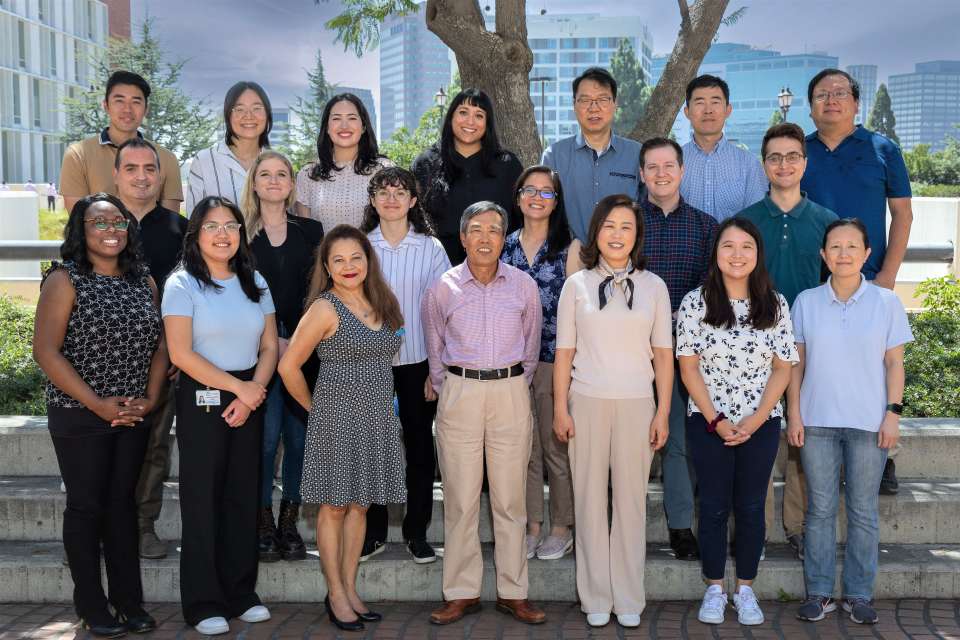Genomics
Overview
The Genomics Shared Resource (GSR) is a fully automated, high-throughput genomic Center equipped with all major bulk sequencing, single cell multiomics and spatial genomics technologies. The GSR provides state-of-the-art technologies, comprehensive services, and specialized expertise, enabling these services in a cost-effective and timely manner to serve basic science and translational/clinical research. In addition, The GSR provides pre-experiment consultation and post-experiment support, including preparation of grant applications, publications, and strategic planning for additional research steps. The GSR also provides educational training to faculty, staff, and students to raise awareness of new directions and major discoveries in the areas of genomics and bioinformatics.
Goals and Mission
- To provide long and short read sequencing (third-generation and next generation/second-generation) to the research community
- To develop and maintain the highest quality and reliability for the genomic services that we offer
- To lead in establishing quality standards for genomic services (e.g., sample processing, data analysis, and interpretation)
- To advance the relatively new specialty area of personalized medicine through education, research, and publications
Leadership

Mailing Address
38-123 CHS
650 Charles Young Dr.
Los Angeles, CA 90095
UCLA Mail Code 173517
Telephone: 310-206-3945
Fax: 310-825-3570
Email: [email protected]
Technology Center for Genomics & Bioinformatics (TCGB): Go to website

Services
- DNA/RNA Isolation - 1 to 2 days
- Quality Control - Same day or next day
- Single Cell Multiomics
- 10X Single Cell - 1 to 3 days
- BD Rhapsody - 2 to 3 days
- Spatial Genomics
- 10X Visium - 2 days
- Visium HD - 1 week
- GeoMx DSP - 3 days
- CosMx SMI - approximately 1 week
- Xenium - 2 to 3 days
- StereoSeq - 1 week
* Please note that sequencing will be separate for Visium, GeoMx, and StereoSeq
- Bulk Sequencing
- Long Read Sequencing/Oxford NANOPORE GridIONX5 - 2 to 3 days
- Next Generation Sequencing - 1 to 3 weeks
- Data Analysis - 1 to 3 days
- Others (including QRT-PCR) - variable based on request
Long Read Sequencing (Third Generation) and Next Generation Sequencing (Second Generation)
DNA and RNA sequencing is the process of determining the nucleotide order of a given DNA fragment. The nucleotide sequence encodes the necessary information that allows living things to survive and reproduce. Determining the sequence is therefore useful in researching into how organisms live. Our core facility provides many sequencing options to meet your individual needs, utilizing (a) Oxford NanoPore GridIONx5 Long-Read Sequencing (by reading the nucleotide sequences at the single molecule level), and (b) Illumina Short-Read Sequencing (by massive parallel sequencing of millions of DNA fragments and yielding substantially more throughput reads quickly).
- Whole Transcriptome Sequencing (RNA-Seq)
- Copy Number Variation Sequencing (CNV-Seq)
- Small RNA Sequencing (miRNA-Seq)
- Chromatin Immunoprecipitation Sequencing (Chip-Seq)
- Methylation Sequencing (Methyl-Seq)
Single Cell Multiomics
10X Single Cell Library Construction
The Chromium 10x Genomics 3’ Single Cell Gene Expression Solution provides a comprehensive, scalable solution for cell characterization and gene expression profiling of hundreds to tens of thousands of cells. The Chromium Single Cell Immune Profiling simultaneously examines the cellular context of the adaptive immune response and immune repertoires of hundreds to tens of thousands of T and B cells in human or mouse tissue on a cell-by-cell basis. The newest one is the Chromium Single Cell ATAC (Assay for Transposase Accessible Chromatin), which accelerates the understanding of the regulatory landscape of the genome, providing insights into cell variability.
- 3’ GEX Library Prep (Fresh Cell)
- 3’ GEX Fixed/FFPE RNA Profiling (FRP) Library Prep
- 3’ GEX + FB (Single Cell Hashing) Library Prep
- TCR Library Prep
- 5’ GEX + TCR Library Prep
- 5’ GEX + TCR + BCR Library Prep
- 5’ GEX + FB (Single Cell Hashing) Library Prep
- ATAC Library Prep
- Multiome (ATAC + 3’GEX) Library Prep
The BD Rhapsody™ Single-Cell Analysis System offers a fast and easy way to collect a wealth of information about individual cells, including their genes and proteins. This is achieved through a unique cartridge system and a sophisticated barcoding technique. The collected data can then be used to create specialized libraries for next-generation sequencing (NGS), a powerful tool for analysing massive amounts of genetic information. By analysing these NGS libraries, researchers gain a deep understanding of individual cells, uncovering hidden patterns and insights invisible to traditional methods.
- BD Rhapsody™ WTA Library Prep
- BD Rhapsody™ WTA + Sample Tag Library Prep
- BD Rhapsody™ WTA + Sample Tag + AbSeq Library Prep
Spatial Genomics
Each organ of a complex organism consists of diverse cell types that often interact in highly structured manners under distinct microenvironments. Such highly structured spatial heterogeneity enables the organism to function correctly and efficiently. To fully understand gene functions in a given cell type, one must study gene expression in the context of the location of the cells in the tissue. Spatial transcriptomics is a recently developed transformative technology that combines the strengths of the global transcriptional analysis of bulk RNASeq and In-situ hybridization, providing transcriptomics data in the context of spatial locations of the cells in situ.
Six spatial transcriptomics technologies are commercially available today: (1) The 10X Visium spatial transcriptomics from 10X Genomics (2) Visium HD spatial gene expression from 10X Genomics (3) GeoMx digital spatial profiler (GeoMx DSP) from NanoString Technologies (4) CosMx SMI for single-cell imaging from NanoString Technologies (5) Xenium single cell spatial imaging platform from 10X Genomics and (6) Stereo-seq Transcriptomics Solution from STOmics. Fresh or FFPE tissues can be applied to 10X Visium, GeoMx DSP, and CosMx and fresh or PFA fixed tissues to Stereo-seq:
- Visium Gene Expression (GEX)
- Visium Tissue Optimization (TO)
- Visium Whole Transcription Analysis (WTA) with CytAssist
- Visium Whole Transcription Analysis + Protein Expression (WTA + PEX)
- Human or Mouse Whole Transcription Analysis (WTA)
- GeoMx Whole Transcriptome Analysis for Human & Mouse
- GeoMx Cancer Transcriptome Analysis for Human
- GeoMx Protein Profiling
- CosMx Universal RNA Panel for Human
- CosMx Immuno-oncology RNA Panel for Human
- CosMx Neuro RNA Panel for Mouse
- 10X Xenium Panel (users provide specific gene panel)
- Whole Transcriptome Analysis for Any Species
Advanced Data Analysis
The TCGB has various academic and commercial data mining software and other resources for genomic data analysis, including Partek flow, VarSeq, Ingenuity Pathway Analysis, Falcon automated genomic analysis system, Hoffman2 data analysis clusters, Illumina basespace Sequencing Hub professional, Amazon cloud HIPAA compliant research computing, and storage system server.
- Standard NGS Analysis
- Advanced and customised data analysis, including 10X single cell and spatial data analysis
- Online data delivery, long term storage and data retrieval
- Data analysis tutorial
- BioTuring
Other Services
The TCGB hosts not only informative seminars on cutting-edge technologies every one to two months but also annual educational workshops offering comprehensive learning experiences. Our core facility also provides:
- RNA/DNA extraction
- RNA/DNA quality control and quantification
- RNA/DNA Purification
- cDNA synthesis for quantitative-PCR
- QRT-PCR
- qPCR Library Quantification
- Covaris Fragmentation
- Size-selection
- Vacuum Concentration
Equipment
The TCGB occupies approximately 2,568 square feet of laboratory space on the third floor of the Center for Health Sciences, CHS 38-123, 38-126 and 33-388. It is operated by seventeen experienced genomic scientists. The TCGB is a high throughput genomic center utilizing the equipment listed below. In addition to offering wet-lab services, the TCGB has developed a broad informatics infrastructure and an efficient means for data acquisition, storage, and analysis. We have access to advanced software including Partek flow, VarSeq, and Falcon automated system, which significantly enhance the overall capacity of TCGB to rapidly process and transform the large quantity of data into novel findings.
Next-Generation Sequencing
- OxfordNANOPORE GriDIONx5 Sequencing System
- 10X Genomics Chromium™ Controller Single Cell Sequencing System
- 10x Genomics Chromium Connect
- GeoMx DSP (Nanostring)
- CosMx SMI (NanoString)
- 10X Visium
- Visium HD
- Xenium
- StereoSeq
- NovaSeqTM X Plus Sequencing System
- Illumina NextSeq 500 Sequencing System
- Illumina MiSeq Personal Sequencer System
- IntegenX Apollo 324 for automated NGS library preparation
- Beckman Coulter BioMek i7 for fully automated workstation
- Fluidigm Access Array System for target-enrichment
- Covaris M220 for DNA shearing
Nucleic Acid Isolation
- Roche MagNa Lyzer instrument for automated tissue homogenization
- Biochain AnaPrep Automated Nucleic Acid Preparation System
- Qiagen QIAcube HT Automated mid- to high-throughput Nucleic Acid Purification System
Quality Control
- Agilent 2100 Bioanalyzer
- Agilent 2200 Tapestation
- NanoDrop 8000
- Qubit 3.0 Fluorometer
- Fragment Analyzer
- Varioskan Lux Plate Reader
Other
- Applied Biosystems 7500 Fast Real-Time PCR System
- Bio-Rad C1000 Touch Thermal Cycler
- Thermo Scientific DNA120 Speedvac Concentrator
Data Analysis (Software) / Other Resources
- Partek flow
- VarSeq
- Falcon automated genomic analysis system
- Hoffman2 data analysis clusters
- Illumina base space Sequencing Hub professional
- Amazon cloud HIPAA compliant research computing and storage system
Operational policies and procedures
The GSR has the following operational policies:
- Before each experiment, the director and co-director schedule two meetings with the investigator and their staff. The first meeting is to discuss experimental strategy and the second meeting is to discuss technical issues and expenses
- When a sample arrives, the GSR performs vigorous quality control before, during, and after each experiment. When quality meets established standards, the lab manager delivers the data to the investigator and saves a copy on the GSR data storage server for a minimum of two years
- After completion of the experiment, the GSR assists investigators in data analysis, publication, and grant application preparation, on request
To ensure the highest quality services, the GSR has the following use policies:
- Quality assurance: Data quality assurance occurs when initial samples pass GSR quality controls (QC). The GSR follows strict QC guidelines to ensure data quality equal to or above that of quality specifications by instrument or kit manufacturers.
- Flexibility: Investigators can use GSR services at any stage they choose. As an example, GSR services can start from tissue and deliver analyzed data or start from a pre-constructed library and deliver raw data. The GSR will make every effort to meet investigators’ specific scientific needs.
- Hours of operations: The GSR is accessible from 8:00 AM to 6:00 p.m., Monday through Friday. Users can access the GSR after-hours by arrangement with the lab manager.
- Turnaround time: GSR automation enables quick turnaround times in general. Although the GSR prioritizes JCCC investigators projects, 85% of NGS samples process within two weeks, and 100% of microarray samples process within one week of receipt for JCCC, non-JCCC, and non-UCLA users alike.
- Priority: JCCC members are given highest priority, non-JCCC UCLA investigators have second priority, and outside users are assigned the lowest priority. However, amongst outside users, cancer researchers from other cancer centers receive preferable scheduling.
- Low price: The GSR has three price tiers for each service. The fees for the majority of services are below or similar to reagent costs for JCCC members and are below or similar to “reagent costs + labor” for non-JCCC UCLA investigators. The large number of outside users make these preferential prices possible for JCCC investigators (for a full list of prices, see below).
